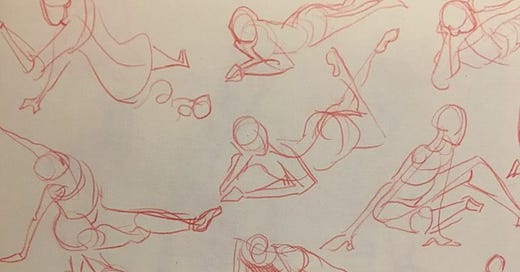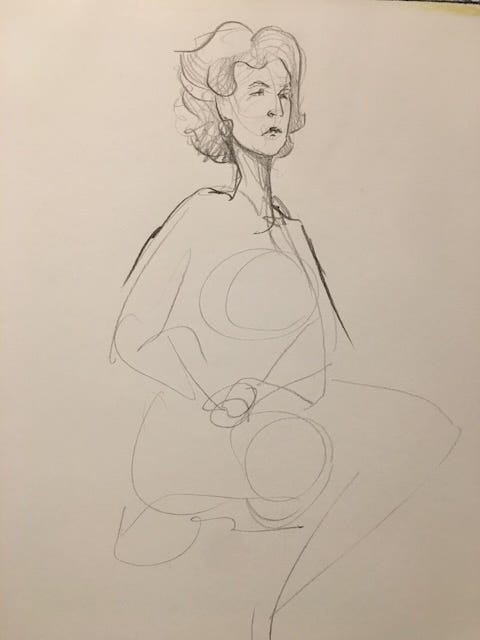♦♦[ART] Figure Drawing. Mastery Requires Four Pillars of Expertise, because Nothing Easy is Worthwhile.
Powerful Composition, Dynamic Gesture, Meticulous Proportions, and Accurate Anatomy are ALL needed for great drawings that live. Incrementally work toward mastering alL four. Don't fixate on one.
This article follows a blunt conversation, and it builds upon my previous article on Gesture. But let me clarify, gesture itself is not sufficient for great drawings. I didn’t imply that if you nail gesture, you’re done.
In my May 28th article, Will asked, "Why gesture?" (I'm paraphrasing.)
Why? Because, they’re the acting component of a drawing. They capture the dynamism of the pose. They answer, "What's the verb?" "What's this figure actually doing?"
But as we compared notes, it became obvious. Students often get lost chasing one pillar of drawing and neglect the others. In LA, it was usually gesture. In NYC, it's often either construction or observation.
The result?
Drawings that bounce with energy but collapse under scrutiny.
Or figures that are anatomically solid but lifeless.
The Four Pillars: What's Necessary for Holistic Drawing
Let's clarify: gesture, construction/anatomy, observation, and picture-making/composition are all essential.
Here's what they are, what they're for. Neglect any and your drawings will suffer.
Gesture (The Spark)
The energy, intent, and story behind the pose. Without it, figures are stiff and dead. With it, you get weight, action, and presence.
"Draw verbs, not nouns." —Walt Stanchfield
Construction & Anatomy (The Structure)
The bones, masses, and mechanical rules that keep your figures grounded in reality. Without it, a gesture is just a series of wild marks with no believability.
Knowledge of construction and anatomy is what lets you check and fix mistakes and understand what's actuallypossible in real space.
Observation (The Honesty)
Learning to see what's actually there, not just what you think is there. Shadow shapes are a great example. The shadow is never where your brain says it should be. Life is much more chaotic than expected. Measuring, checking, and developing the eye to capture reality. Without it, you're just recycling clichés and visual shorthand.
Picturemaking & Composition (The Context)
Understanding the edge of the page or panel is as important as the figure itself. Every drawing exists in a frame—composition is about making your image compelling as a whole, not just as a figure. Start early: draw a frame, consider the placement, and remember that every element is part of a bigger picture.
"You interpret, not copy." Glenn Vilppu
You Need All Four — Not Just One
A killer gesture drawing with broken anatomy or incoherent proportions is just as much a failure as a beautifully constructed, motionless mannequin. Our brains are wired to spot errors—subtle or glaring—in the human form, and the viewer's experience is shaped by their unconscious sensitivity to weight, motion, proportion, and placement.
Constraints (like anatomy, construction, and the edge of the frame) are your friend: they narrow infinite options and force you to make meaningful, believable choices.
The Learning Spiral: Absorbing Incrementally but Deliberately
To produce holistic, professional work faster, you need to cycle through all four pillars repeatedly. Don't stay in one arena for too long.
My Recommendation:
Hit Gesture: Capture the action, the bounce, the intent, the weight, the VERB.
Move to Construction/Anatomy: Build the form, check proportions, and understand joints and their range of motion and limitations.
Shift to Observation: Measure, compare, match the angles, find the outside envelope. Check your work against reality.
Finish with Picturemaking: Frame your drawing, consider composition, and think about how your figure fits in the broader visual story.
As you improve, each cycle through this spiral becomes increasingly intentional. Your drawings get stronger, more expressive, and more believable.
The Last Line
Gesture brings the body to life, but it can't survive alone. Construction and anatomy keep your figures honest. Observation anchors your drawings in reality. Picturemaking puts everything in context, making each image a complete and compelling statement. You need all four.
If you're tired of producing "pretty corpses," commit to the whole process. Master each pillar, cycle through them, and you'll finally draw figures that live—on the page, in the panel, and in your viewer's imagination.
Charles Merritt Houghton
23 June 2025
BONUS DIAGNOSTIC:
Signs You're Neglecting One or Several of These Pillars.
Breaking Figure Drawing Into Manageable Chunks
Keep reading with a 7-day free trial
Subscribe to The Invisible Thread - Making Comics by Charles Houghton to keep reading this post and get 7 days of free access to the full post archives.






